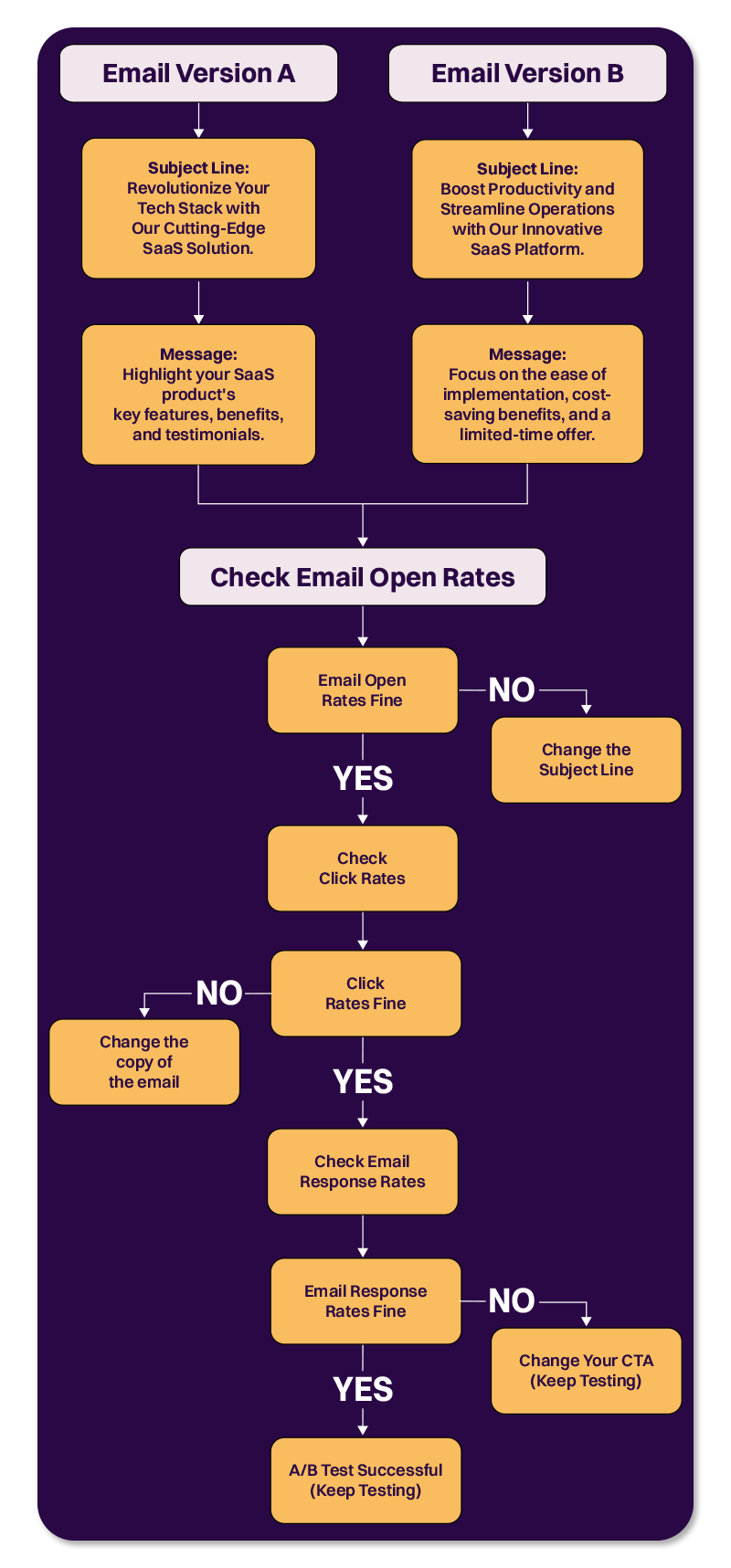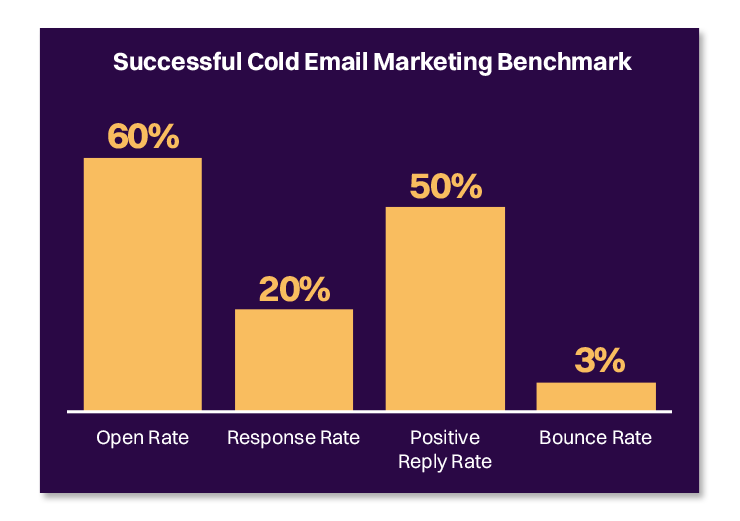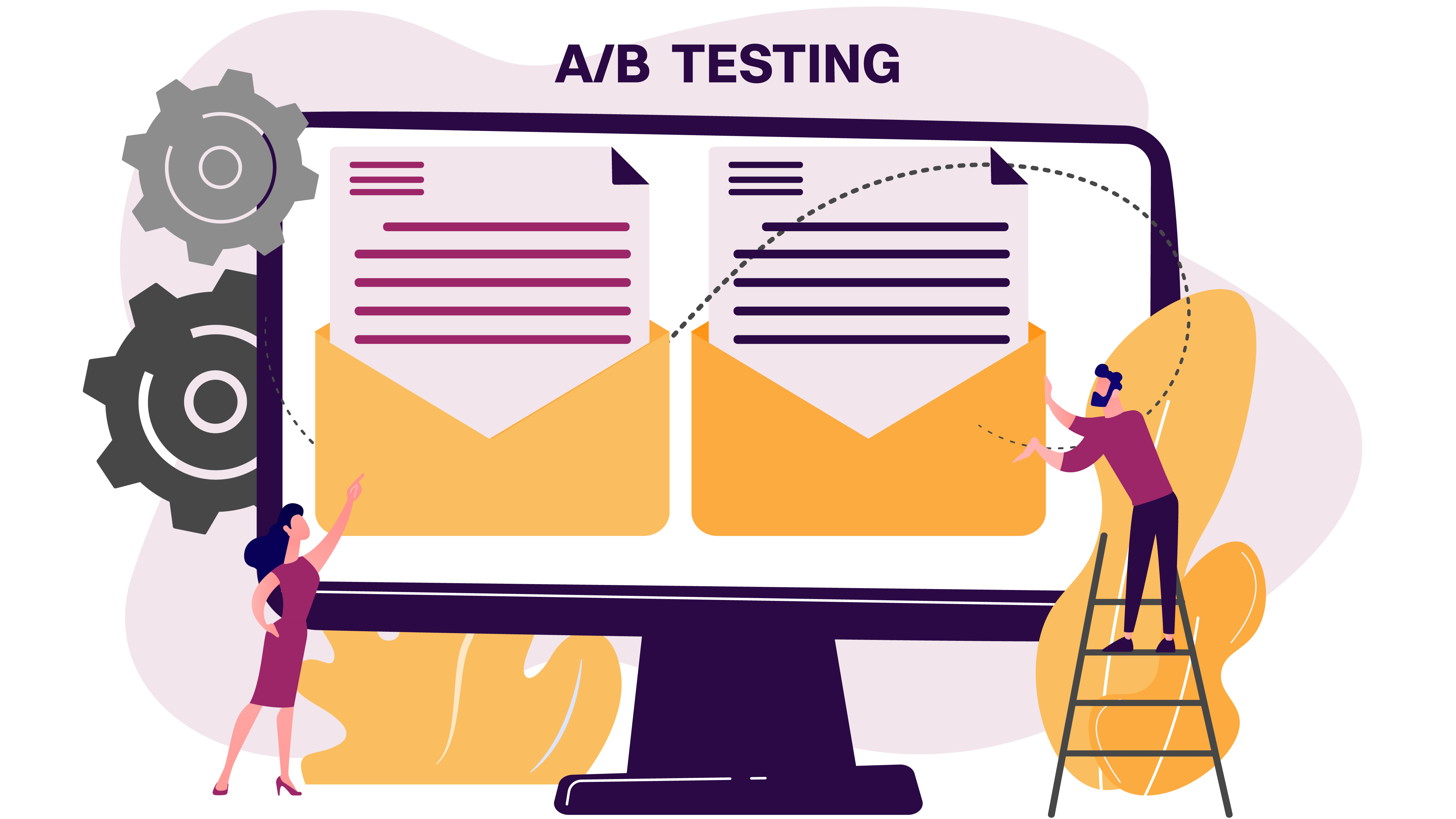
Cold Email A/B Testing Strategies: Unveiling the Secrets of Success
8 out of 10 customers prefer brands to contact them by email, and cold emails give them optimum time to learn about your product/service. However, crafting a perfect cold email campaign on the first attempt is difficult.
This is where you need to apply the cold email A/B testing. It tells you what adjustments you need to run a successful cold emailing campaign.
By leveraging this tactic, you can improve your approach, enhance personalization, and increase engagement. In this blog, you will get a detailed analysis of the A/B testing for cold emails and how it can help you achieve your goals.
So, unlock the secrets of effective B2B outreach and supercharge your results. But before we start, let’s take a look at a real-world example of cold email testing’s effectiveness reported by Revnew.
Revnew’s Cold Email A/B Testing Case Study
The below screenshot shows the cold email A/B testing report by our Revnew experts.

Our experts ran a successful A/B test for one of our clients. The test elements included different types of subject lines for cold emailing. We tried the following subject line versions to figure out what works best for our client’s cold emailing campaign:
- Adding the prospect’s first name in the subject line and body.
- Mentioning industry-specific statistics.
- Adding prospects’ major pain points.
- Mentioning any notable achievements, testimonials, or recognitions to establish credibility and trust.
- Highlighting the benefits or value proposition.
Results: The campaign reached out to 1328 target contacts. A/B tested emails showed the following impressive outcomes:
- 80% open rates
- 2% bounce rates
- 19% reply rates
- 0% unsubscription rate
Now, let’s begin with learning about the cold email A/B tests in detail.
How We Generated 32 Quality Leads for Core-LX in Just 2 Months

Understanding What Is A/B Testing For Cold Emails
A cold email A/B test or split testing is a method used to compare and evaluate the effectiveness of different variations of a cold email campaign.
The goal of the A/B test is to determine which version of the email is more successful in terms of the following:- Generating responses
- Conversions
- Achieving the desired outcome
The most common elements that you can compare in a cold email using A/B testing are:
Subject Lines
You can test different subject lines to find the ones that grab attention and entice recipients to open your emails.
A few great examples of the B2B subject lines are:
- "Boost Your ROI by 50% with Our New Marketing Strategy."
- "Exclusive Invitation: Join Industry Leaders at Our Networking Event"
- "Unlock Your Business Potential with Our Revolutionary Software"
- "Limited Time Offer: Save 30% on Our Best-Selling Products."
- "Discover the Secret to Cutting Costs without Sacrificing Quality"
Personalization
Different prospects react differently to personalized and non-personalized emails based on industry type. Using the A/B testing for cold emails, you can check the response rate for both. It lets you identify which performs better for your B2B outbound lead generation.
For example, you can divide your prospect list into two parts. Share personalized emails with prospect names to the first half and non-personalized ones to the second. Check and compare the responses you receive. The one with a high rate of positive responses is better to adopt.
Email Length
Depending upon the need, you can decide the length of your email. But comparing shorter and longer emails is important to see which ones are more effective for your unique audience.
For example, compare a concise email that gets straight to the point with a longer email that provides more detailed information. Measure the response rates and engagement levels to determine which length resonates better with your target audience.
Call-to-Action
You can get better leads after testing different CTAs to discover which prompts make recipients take the desired action more. The open rate for cold email marketing is around 20%. Therefore, focus on adding appealing CTAs, such as:
1. "Schedule a consultation call to discuss how our solution can benefit your business."
2. "Click here to download our whitepaper and learn more about industry best practices."
3. "Book a product demo to see how our software can streamline your operations."
Design And Layout
You can select from many email outlines and layouts available. While it's important to have attractive emails, it is equally important to make them valuable. Try different email designs and layouts to identify the ones that visually appeal to your audience and encourage them to engage with your content.
For example, you can create and send two emails to different prospects. Keep one email clean and minimalist with a clear hierarchy of information and a CTA. Try the second one as a text-heavy email layout with a concise and scannable format. Check the response to the emails to see which performs better.
By conducting A/B tests on these elements, you can refine your cold email strategy and achieve better results in your outreach efforts. It can improve your chances of attracting qualified leads and nurturing successful B2B partnerships. Let us help you understand this better.
A/B Testing's Role In Understanding Prospect's Preferences
Using the A/B for cold emails can help easily analyze prospect preferences. By conducting A/B tests, you can gather valuable insights into what resonates with your target audience and tailor your messaging accordingly.
As a B2B business, you can use the A/B testing differently. From comparing landing pages to emails and campaigns, you can use this testing to personalize the user experience. Here are a few points about A/B testing's role in understanding prospect preferences:
- Identifies key variables for generating a positive response.
- Allows comparison of multiple options to find the best-performing elements.
- Enhances personalization based on visitor preferences.
- Drives data-driven decision-making for optimizing cold email campaigns.
Based on these criteria, you can set the benchmark. It can be a response rate or conversion, as per your need. You can see which headline or cold email gets more scores and use that in your campaign.

A Quick Example
Suppose you want to share a cold email to promote your new product to potential clients in the technology industry. You conduct A/B testing on two different email versions to understand prospect preferences. Here are the sample emails:

By sending these emails to different segments of your target audience, you can analyze the following:
- Response rates
- Open rates
- Click-through rates
Using these factors, you can determine which email version resonates more with your prospects. Based on the outcome, you can understand the prospect's preferences better. With this approach, you can optimize your future email campaigns based on the insights gained from A/B testing.
What Are The Types Of Cold Email A/B Testing?
You should be aware of 3 different types of A/B tests. The details of all three are discussed below:
1. Simple Split Testing
Split testing involves comparing two cold email versions by splitting the incoming traffic between them. By measuring the performance of each version, such as conversion rates or engagement, you can determine which version is more effective. Split testing empowers you to unleash the true potential of your cold emails.
2. Multivariate Testing
Multivariate testing allows for simultaneous testing of multiple variations across different emails. This approach enables the evaluation of the combined impact of various changes, such as:
- Headlines
- Images
- Call-to-action (CTA) buttons
- Layouts
- User behavior
- Conversion rates
How Can You Use A/B Testing In Email Campaigns?
When you plan to conduct the A/B test for email campaigns, you must focus on three stages. They are:
1. Before the A/B testing
2. During the A/B testing
3. After the A/B testing
Below are the detailed steps to be followed under each.
Before the A/B Test
- Pick One Variable To Test: Select a specific element in your email campaign, such as:
- The subject line
- Sender name
- Email design
- CTA
- Content length
- Identify Your Goal: Define the primary metric or objective you want to focus on during the A/B test, such as:
- Open rates
- Click-through rates
- Conversions
- Any other relevant metric.
- Create A 'Control' And A 'Challenger': Set up your control email, representing the existing version you want to test against. Then create a challenger email with a variation of the chosen variable.
- Split Your Sample Groups Equally And Randomly: Divide your email list into two equal and random segments. Assign one segment to receive the control email and the other segment to receive the challenger email.
- Determine Your Sample Size: If you have an extensive email list, you may need to determine the appropriate sample size for statistically significant results. Ensure your sample size is sufficient to draw reliable conclusions. The recommended sample size to compare is five templates at a time.
- Decide How Significant Your Results Need To Be: Determine the desired level of confidence or significance level for your results. A standard threshold is a confidence level of 95% to ensure reliable and meaningful outcomes.
During the A/B Test
- Use An A/B Testing Tool: Utilize an A/B testing tool or platform specifically designed for email campaigns to segment and send the control and challenger emails to the respective audience segments. Some tools that you can use are:
- Test Both Variations Simultaneously: Ensure the control and challenger emails are sent simultaneously to eliminate potential timing biases and accurately compare their performance.
- Give The Test Adequate Duration: Allow sufficient time for the test to run and gather a substantial sample size to obtain statistically significant results. The duration may vary depending on your email volume and audience engagement.
- Ask For Feedback From Real Users: Alongside quantitative data, consider collecting qualitative feedback from recipients through surveys or polls to gain insights into their preferences, motivations, or reasons behind their actions.
After the A/B Test
- Focus On Your Goal Metric: Analyze the results of the A/B test and compare the performance of the control and challenger emails based on the primary metric you identified earlier.
- Measure The Significance Of Your Results: Use an A/B testing calculator or statistical analysis to determine the statistical value of the results and whether the observed differences are statistically valid.
- Take Action Based On Your Results: If one variation significantly outperforms the other, implement the winning version as the new standard for your email campaign. Disable the underperforming variation. If the results are inconclusive, stick with the original version or run another test with revised variables.
- Plan Your Next A/B Test: Use the insights and learnings from the previous A/B test to plan future tests, continuously optimizing your email campaigns. Further, consider testing different variables or iterations to enhance engagement and conversions.
Leverage Cold Email Benchmarking

To ensure your campaign works in your favor, measure these cold email benchmarks. Also, the recommended statistics mentioned below are based on our experiments and experience and our discovery.
1. Open Rate - Recipients’ percentage opening your emails. If it’s:
- Above 60% - Great.
- Below 40% - Improve subject line quality.
2. Reply Rate - The total sent emails proportion that receives a reply. If it’s:
- 20% or more- You are doing good.
- Below 20% - Improve your email list qualities, and test various calls-to-actions CTAs.
3. Adjusted Reply Rate - Your email's effectiveness rate through the ratio of the total replies you receive to the total opened emails. A/B tests different emails to increase the rate.
4. Positive Reply Rate - Compare positive prospects’ responses to negative ones. If it’s:
- 50% or above- Recipients like your content.
- Below 50%- Test various CTAs, and add social proof.
5. Bounce Rate - The total sent emails percentage that does not enter recipients' inboxes. If it’s:
- Below 3-5% - Most of your emails reach their destinations.
- Above 5% - Verify the accuracy of your email listing.
Benefits Of A/B Testing
There are various benefits of using A/B testing for evaluating email campaigns. When it comes to cold emails, you must ensure they are impactful. You must analyze and compare the emails to find the best version.
The main benefits include the following:
Increased Open Rates
A good subject line gets your email opened. But how do you know which one(s) is effective?
A/B testing allows you to test different subject lines in your cold emails.
For instance, you could test a subject line highlighting the recipient's pain point against one offering a compelling benefit.
By analyzing the open rates of both variations, you can determine which subject line resonates better with your target audience, leading to increased open rates.
Higher Click-Through Rates
A/B testing enables you to experiment with different CTA elements in your cold emails. You can test variations of CTAs such as:
- Button color
- Text
- Placement
For example, you might test a CTA that emphasizes a time-limited offer against one that focuses on a free resource.
By tracking the click-through rates, you can identify the CTA variation that drives higher engagement and directs recipients to your desired landing page.
Improved Conversion Rates
A/B testing helps you optimize your cold email content to boost conversion rates. You get to test different email templates or messaging styles.
By analyzing the conversion rates of both variations, you can determine which approach generates better responses and increases the likelihood of converting leads into customers.
Evaluate the Need For Personalization
A/B testing allows you to experiment with personalization techniques in your cold emails.
For example, you can test personalized subject lines or customized email body content. Let's say you're testing the inclusion of the recipient's company name in the subject line or email introduction.
By analyzing the response rates, you can identify the level of personalization that resonates best with your target audience.
Data-Driven Decision Making
A/B testing provides valuable data and insights about your cold email campaigns. You can make informed decisions based on real data rather than assumptions by tracking metrics such as open, click-through, and conversion rates.
If one variation consistently outperforms the other regarding open and click-through rates, you can confidently optimize your cold email strategy based on these insights.
Better Understanding Audience
A/B testing assists you in understanding your target audience's preferences and behaviors. By testing different variations on subsets of your outbound leads, you can gather insights into how different segments respond to various elements.
For example, you might find that one variation performs better with a particular industry or job title. Now, you can tailor your future cold emails to that specific segment. Thus, it is likely to result in more targeted and effective messaging.
Optimal Resource Allocation
A/B testing allows you to allocate resources more effectively in outbound lead generation. You can identify the strategies that yield the best results by testing different elements.
Continuous Optimization
A/B testing promotes continuous optimization of your cold email campaigns. By constantly testing and refining your outreach efforts, you can:
- Stay ahead of changes in the market
- Adapt to evolving customer preferences
- Incorporate emerging trends
This iterative approach ensures your outbound lead generation remains effective and consistently generates quality leads.
A/B Testing's Impact On Email Deliverability And Avoiding Spam Filters
By following best practices and implementing careful testing, you can improve the chances of your emails reaching the recipients' inboxes rather than being marked as spam.
Here are some key points to consider:
- Reputation Management: A/B testing helps build a positive sender reputation by consistently sending high-quality emails that receive positive engagement.
- Subject Line Testing: Test different subject lines to avoid spam filters and increase the chances of emails being delivered to inboxes.
- Content Testing: A/B testing optimizes email content by testing formatting, images, links, and length to comply with best practices and maximize delivery.
- List Segmentation: Segment your email list and send targeted, relevant content to improve engagement and reduce the risk of being flagged as spam.
- Email Authentication: Test email authentication protocols like:
- Sender Policy Framework (SPF)
- DomainKeys Identified Mail (DKIM)
- Domain-based Message Authentication, Reporting and Conformance (DMARC)
-to establish trust with email service providers and reduce the likelihood of spam marking.
- Compliance With Anti-Spam Laws: Ensure the email content includes relevant information, proper identification, and an easy opt-out mechanism to comply with anti-spam laws and maintain a trustworthy sender reputation.
- Continuous Monitoring And Analysis: Regularly monitor metrics like bounce rates, spam complaints, and deliverability rates to identify issues and take corrective measures promptly.
You can optimize your email campaigns to ensure better deliverability rates and maintain a positive sender reputation.
5 Cold Email A/B Testing Mistakes To Avoid
Using A/B testing for cold emails is simple. But a few things should be avoided at all costs to avoid any lapses in results. The most important ones are:
1. Insufficient Test Duration
Failing to run the A/B test long enough can lead to inconclusive results. So, ensure an adequate sample size and duration to gather statistically significant data.
2. Tracking Multiple Metrics
Too many metrics can dilute the focus and make it difficult to draw clear conclusions. Thus, identify the primary metric that aligns with your goal and prioritize its measurement.
3. Poor Timing
Testing emails at the wrong time can skew the results. Therefore, consider factors such as time of day, day of the week, and your target audience's behavior to ensure proper testing conditions.
4. Testing Too Many Elements
Testing multiple elements simultaneously makes it challenging to attribute changes in performance to specific variables. Test one variable at a time to understand its impact accurately.
5. Incorrect Sample Size
Using an inaccurate sample size can compromise the validity of your A/B test. Calculate the sample size required for statistical significance and ensure your test groups are adequately represented.
Further, by avoiding these common A/B testing mistakes in cold email campaigns, you can achieve three critical outcomes:
1. Gain more accurate and actionable insights.2. Make informed decisions.
3. Optimize your outreach efforts and improve conversion rates.
Conclusion
A/B testing is crucial in maximizing the effectiveness of cold email campaigns and driving better conversion rates. By steering clear of common mistakes and leveraging the expertise of Revnew, you can streamline your lead-generation process and secure appointments with influential decision-makers.
Don't let valuable leads slip away. Take action now and reach out to Revnew to explore our comprehensive services in outreach efforts and sales automation. Together, we can transform your potential clients into delighted customers.
Contact us today and unlock the full potential of your cold email outreach.




